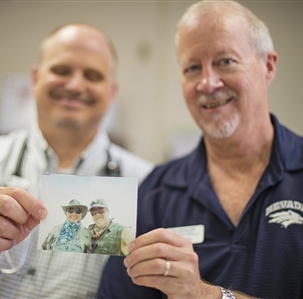How to survive Burning Man
The do's and don'ts of taking care of oneself at the Burning Man event
(Note: University of Nevada, Reno School of Medicine Associate Professor Gary Johnson, M.D., has seen some playa dust in his time. As a 25-year veteran of Burning Man and a former member of the festival's medical team, he's also seen the type of maladies that come with a week of extreme temperatures, low visibility for drivers and cyclists, dust and more dust. From your journey to the desert, to your final day on the playa, Dr. Johnson shares his time-tested safety tips.)
Prep for the journey
Watch speed limits carefully when going through Wadsworth, Nixon, Empire and Gerlach. Give yourself plenty of time to get through the gate on the playa, and even more getting out after the burn. Traffic, accidents, rain and dust storms can bring your travels to a halt any time of the week, and there is always a possibility of being stuck in your car for 12 hours or so.
For the trip in, I recommend packing:
• Full gas tank, extra set of car keys, windshield wiper fluid
• Consider carrying additional gas, but only if you can do so safely
• Snacks/food, blanket, water, book or magazines
• Bottle for urine/sealable container
Bike basics
A wide-tire mountain bike or beach cruiser is important. You should have a bike lock, water bottle cage and a tennis ball for your kickstand (so it doesn't sink into the playa). You also want to be very visible out there, so put plenty of lights on your bike and your body.
More about those lights
I like battery-powered LED light strings for your body and bike, and solar-powered LED for camp. Electroluminescent (EL) wire can be great, but is expensive and can be unreliable. Glow sticks are wasteful and gauche, but OK in a pinch.
Daily camp essentials
Don't leave camp without a hat, bandana, goggles and water. Consider a pack to hold those items along with lights for your body, a headlamp, some cash for coffee or ice, sunblock, snacks and a little toilet paper, which can all fit into a gallon zip seal plastic bag. You may want to sample some of the coffee, food and alcohol offered as gifts, in which case carry a plastic cup, spoon and a photocopy of your driver's license. Also, learn how the streets are laid out before venturing out on your own. Landmarks, including street signs, start disappearing later in the week.
Bring a warm sweater for the evenings when the temperature dips. And it's always a good idea to pack baby wipes for bathing, extra sunglasses, trash bags, a first aid kit, a pocket multi-tool and a lawn chair (fold it up when leaving camp).
Cell phones
Cell service can happen, but is more and more unreliable as the week goes on. Dust is hard on electronics, and hundreds of phones get lost every year. For your own safety and to ID your cell phone, take a picture of a sign stating your name, playa address and home address and set it as your lock screen.
Shelter
If you're tenting it, you'll need longer (10-12 inch) stakes to keep your shelter from blowing away. If using rebar, cover the tips to avoid lacerations. A heavy cooler chest inside the tent is a good option. Try setting your tent up while it is still light outside to avoid inadvertently encroaching on theme camps or villages.
Playa Foot
When you first arrive on the playa, the dust feels like talcum powder. After a few days, the alkali in the powder causes a type of burn, known as "playa foot." Bring white vinegar to soak dusty feet and other areas. Mix vinegar with water 1:4, and follow with moisturizer.
Desert dining
You may not feel like cooking. Previously prepared, simple meals are often the best. You still want some sort of cook stove, utensils, plates and a table for it all.
Odds and ends
• Bring all necessary medications. This is particularly true if you take pain medicines or sleep aids, as the medical tent cannot provide them for you.
• Find something funky to wear. Stay away from boas, glitter or anything that could leave litter.
• Physical gifts aren't absolutely essential; just find ways to contribute.
Bring a gallon and a half of water per person each day. Stay hydrated. But don't just drink loads of water, as it can cause hyponatremia-a condition where drinking too much water can dilute the sodium levels in your blood and can lead to nausea, fatigue, headache or confusion, cramps, irritability and even seizures or a coma in more serious cases. Thirst and the color of your urine are usually the best indications of how much water you need. If you're not thirsty and your urine is pale yellow, you are likely hydrated. Eat crackers or something else salty to keep your sodium levels stable.
Find access to shade beyond your tent.
It's good to take a few days just to get acclimated to the surroundings. And don't forget to bring a good dose of common sense too. The festival is a great place to expand your horizons, but know your limitations and pace yourself.
As a member of Burning Man, a community built on self-reliance, participants are responsible for their own health and basic first aid. However, if you or someone you know (or encounter) requires medical assistance, you may contact an emergency services department volunteer or a Black Rock Ranger, or visit one of the six medical stations. All are easily identified by a large, illuminated red cross. Burning Man also has a Nevada-licensed independent center for emergency care. Trained emergency medical personnel are on duty 24 hours a day.
(Pictured: UNR Med faculty Richard Williams, M.D., and Gary Johnson, M.D., are playa veterans, having provided medical care at Black Rock City for several years. Photo by Brin Reynolds/UNR Med.)





